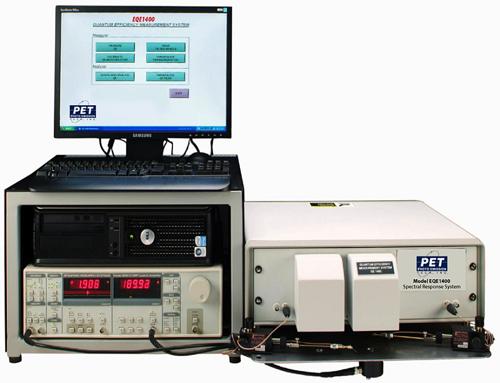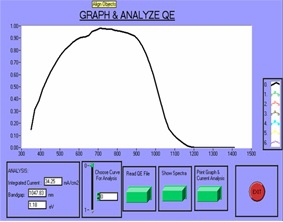Spectral Response Systems
Quantum Efficiency Systems
IPCE Measurement Systems
Quantum Efficiency Systems are a turnkey solution for measuring the Spectral Response, External Quantum Efficiency (EQE) or Internal Quantum Efficiency (IQE). Quantum Efficiency (QE) measurements provide a primary characterization method for completed photovoltaic devices.

QE system provides electronics and software designed for fully automated measurement of external quantum efficiency of solar cells. All systems include probes and a fixed plate sample stage for samples up to 150 mm x 150 mm. The main system components include: custom designed software, measurement electronics, and computer system (Windows 8 operating system).
The measurement involves focusing monochromatic light to a spot on the device under test, then accurately measuring the photon flux and current from the test cell. The system utilizes a dual beam configuration with lock-in detection, providing an absolute accuracy of ±3%. The QE system uses a grating monochrometer with silicon/InGaAs/Ge detectors. The system includes automatic order sorting filters and two light sources for monochromatic illumination (a Xenon- arc lamp and a halogen lamp). A single lock-in amplifier is used to measure both the reference detector and test device. The main system comes with all the hardware needed to measure quantum efficiency, a fixed plate sample stage and probes.


Custom designed software using LabView2009™ provides a user-friendly operation for data collection, plotting and analysis. The software provides flexibility and ease of use in the measurement and manipulation of QE. Full manual control over the mono-chrometer and order sorting filters is provided for diagnostic purposes. The wavelength range and step size during measurements are user definable. Data stored to disc can be directly examined within the supplied software, or can be exported to a text file readable by most third party software packages. Up to six data sets can be plotted on a single graph for comparison. The calculated QE is convoluted with a standard AM1.5 global spectrum to determine the short circuit current.
SYSTEM COMPONENTS
| Computer and Software | Custom designed software using LabView2009™ provides a user-friendly operation for data collection, plotting and analysis. The software provides flexibility and ease of use in the measurement and manipulation of QE. Full manual control over the mono-chrometer and order sorting filters is provided for diagnostic purposes. The wavelength range and step size during measurements are user definable. Data stored to disc can be directly examined within the supplied software, or can be exported to a text file readable by most third party software packages. Up to six data sets can be plotted on a single graph for comparison. The calculated QE is convoluted with a standard AM1.5 global spectrum to determine the short circuit current. |
| Micro-positioners | Sample is mounted on a fixed plate sample stage and probes are provided for making current measurements. |
| Source Lamps | These systems allow a spot size of about 2 mm x 2 mm with two light sources for monochromatic illumination (a Xenon- arc lamp and a halogen lamp). |
| Photodiode | It uses two silicon/InGaAs/Ge detectors for the reference detector and test device. |
| Beam Splitter | The measurement involves accurately measuring the photon flux and current from the test cell using a beam splitter. |
| Precision Light Chopper |
It provides reference frequency for the lock-in detection. |
| 1/8 Mono-chromator | It uses a dual grating mono-chrometer for performing quantum efficiency measurements of cells over the wavelength range from 260nm to 1400nm. |
| Automated Filter Wheel |
The system includes automatic order sorting filters. |
| Digital Lock In Amplifier | The system utilizes a dual beam configuration with lock-in detection. |
| Frame | Welded steel construction, powder coated. |
| Power Requirements | 110/220V, 50/60Hz, single-phase, 20 A |
SYSTEM SPECIFICATIONS
| Solar cell type | Superstrate, Rigid or Flexible, 1-5 mil thickness |
| Solar cell size | Up to 150 mm x 150 mm |
| Grid area | At least 2 mm x 2 mm |
| Cooling | None |
| Solar cell material | CIGS, CdTe, a-Si based multi-junctions, mono-silicon, organic, etc. |
| Mono-chromator wavelength accuracy | ± 0.6 nm, that mono-chromator can read a wavelength, λ by λ +/- 0.6nm. |
| Mono-chromator max resolution | < 1 nm in visible range, that mono-chromator can read two wavelengths separated by 1 nm. |
| Measurement range | 300 nm to 1,100 nm |
| Type of measurement | Internal quantum efficiency with options |
| Operation mode | Automatic, designed software using LabView2009™ |
OPTIONS
Internal Quantum Effeciency Option
A total reflectance measurement using an integrating sphere is OPTIONAL for measurement of Internal Quantum Efficiency (IQE) of a solar cell. The data analysis option calculates IQE= EQE/(1-R), where R is reflection. For monocrystalline silicon based solar cells, this is a must option.
Voltage Biasing
A DC power supply for voltage biasing the test device at up to ±5 V can be included. An electric control box on back of the lock-in-amplifier is included to apply a voltage bias. The voltage bias is very useful sometime to separate individual junctions properly from a multi-junction device. It also helps to look at collection losses in a junction.
White Light Bias and Filter Light Bias Capability
A white light exposure simulates actual solar light conditions in a solar cell where as filtered light bias at different parts of the solar spectrum helps to isolate contributions from individual cells in a multi-junction cell.
Temperature Control Capability
The temperature stage incorporates solid state thermoelectric detectors to provide a controlled measurement of temperature (±1°C) over 10°C to 60°C over a substrate of size up to 150 mm x 150 mm. The system does include a small pump to keep the stage under vacuum so that one does not have moisture build up at low temperatures.
X-Y Stage Capability
The X-Y stage allows moving of a sample in both directions up to 120 mm distances. The main platform is supported by four re-circulating ball carrier bearings mounted to precisely aligned linear guide rails, which together are capable of providing smooth motion for loads up to 20 kg. A backlash-free lead-screw produces smooth translation that is directly driven by a two-phase stepper motor capable of 25,600 micro-steps per revolution, thus yielding a positional resolution of less than 100 nm. Magnetic limit switches allow homing and overdriving protection in both forward and reverse directions. It is driven by stepper motor controllers, which come with its own dedicated software package. The stage provides micro-stepping resolution of 40 nm and speeds of up to 12 mm/s.
Universal Sample Handling Capability
The stage allows the measurement of a solar cell both in superstrate and substrate structures.
Calibrated Detectors
PET will provide two NIST traceable third party calibrated detectors for reference. Detectors will include a silicon photodiode, calibrated from 250-1100 nm and interface cables to connect detectors to the QE system.
Other options are available; please contact us to discuss your requirements.
Individual systems may vary in appearance, components, and features.
